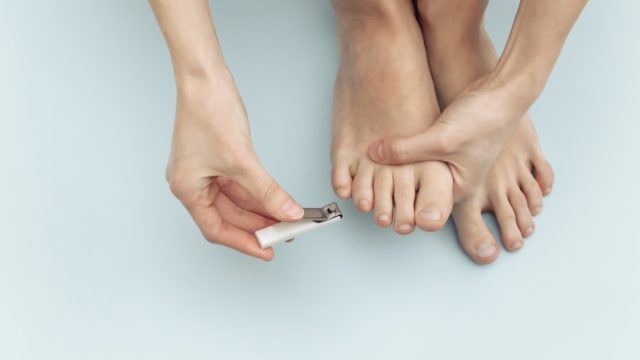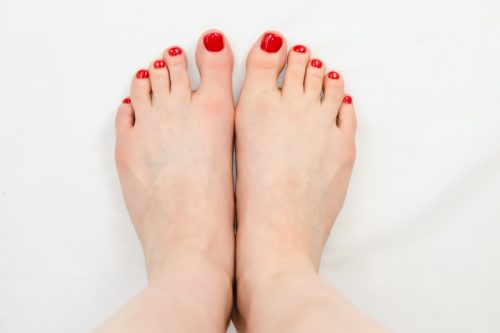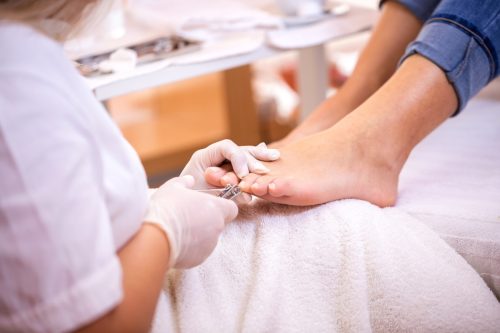What Happens If You Don’t Cut Your Toenails for a Month, According to Podiatrists

Sometimes it seems like our bodies require constant upkeep. Between getting regular exercise, taking supplements to stay healthy, and even showering every day, our wellness and grooming routines can take up a lot of time. But of all the self-care chores you perform, cutting your toenails may be up there with the most tedious. Besides the fact that some people find dealing with feet gross, it requires you to contort your body so you can reach your toes in the first place. And if you’re prone to ingrown toenails, toenail trimming can be painful.
So, what would happen if you went a whole month without cutting your toenails? We asked podiatrists to level with us about how frequently you really need to trim them, how best to do it—and what would happen if you skipped this chore for 30 days straight. Read on to find out what they said.
READ THIS NEXT: What Happens If You Don’t Shower for a Month, According to Doctors.
People may put off cutting their toenails for various reasons.

Bruce Pinker, DPM, a board-certified podiatrist and foot surgeon, says that he’s treated several patients who are reluctant to cut their toenails—or have anyone else do it—because they simply dislike having anyone touch their feet. “These psychological reasons can be complicated,” he tells Best Life. “Some individuals hate feet or are ‘grossed out’ by their feet, especially if they have toenail fungus or deformed toes.”
Lack of flexibility and specific health conditions can be factors as well, says Sondema N. Tarr, DPM, a board-certified podiatrist practicing at Direct Podiatry Arizona in Tempe, Arizona. “For some people over time, as they age, being flexible enough to reach your feet becomes challenging,” she explains. “Also, certain people have health conditions like a previous stroke, spinal bifida, or rheumatoid arthritis, that changes the shape of your feet and makes it harder to trim your nails. Sometimes people’s nail shape can change over time, and nail trimming which was once painless becomes extremely painful.”
Not keeping up with trimming can result in painful ingrown toenails.

“If people don’t trim their nails often enough, ingrown nails can become a problem,” warns Tarr. “As toenails becomes very long, they tend to curl and will grow into the skin.” Ouch.
Pinker notes that walking can become painful if you don’t keep up with toenail trimming, increasing the possibility of trips and falls. As to ingrown toenails, he says that severe cases may require antibiotics. “If the toenails are infected with fungus, mold, or yeast, and they are not trimmed regularly, the infection may spread and lead to athlete’s foot fungus, and possibly cellulitis.”
Trimming toenails once a month—or even less often—is enough for some people.

The good news is, you don’t actually have to cut your toenails as often as you might think. “Several factors like circulation, nutrition, certain health conditions, or previous trauma, can impact how fast your toenails will grow,” Tarr explains. “How often toenails should be trimmed ranges from every three to four weeks for a healthy person, to every nine to 12 weeks for someone with, for example, poor circulation.”
In other words, going a month without performing this ritual may be perfectly fine—but you don’t want to go much longer than that. Pinker recommends that young people give themselves a pedicure every two to four weeks, while “elderly individuals can trim their toenails every one to two months, depending on the rate of growth.”
When you do cut your toenails, Tarr says to trim straight across the nail. “You don’t want to round the corners because that increases the risk of having an ingrown nail. You also don’t want to trim too short, as this can also lead to ingrown nails.”
For more health news sent directly to your inbox, sign up for our daily newsletter.
Certain people should never cut their own toenails.

If you hate cutting your toenails, you might want to head to the salon for a pedicure. And while Pinker says it’s fine for most people to cut their own toenails or go to a salon, he warns that older folks with “very thickened toenails” and people with diabetes should visit a podiatrist for nail trims.
Tarr agrees that nail trims at home or in a salon are fine for people who have no health conditions. But if you have poor blood flow, neuropathy, diabetes, or a combination of the three, you should not be visiting nail salons at all. “These groups of people are at significantly higher risk of infection and amputation of toes of feet,” she says. “Nail care should be performed by medical personnel.”
She and Pinker both stress that if you do go the salon route, it’s important to make sure the one you choose practices good hygiene standards. “At any salon, it is important that the instruments they are using are either disposable and thrown away after each client, or sterilized in an autoclave,” Tarr says. “If the salon you are visiting isn’t doing either of these things, the risk of you contracting nail fungus, plantar warts, or bacterial infection increases significantly.”